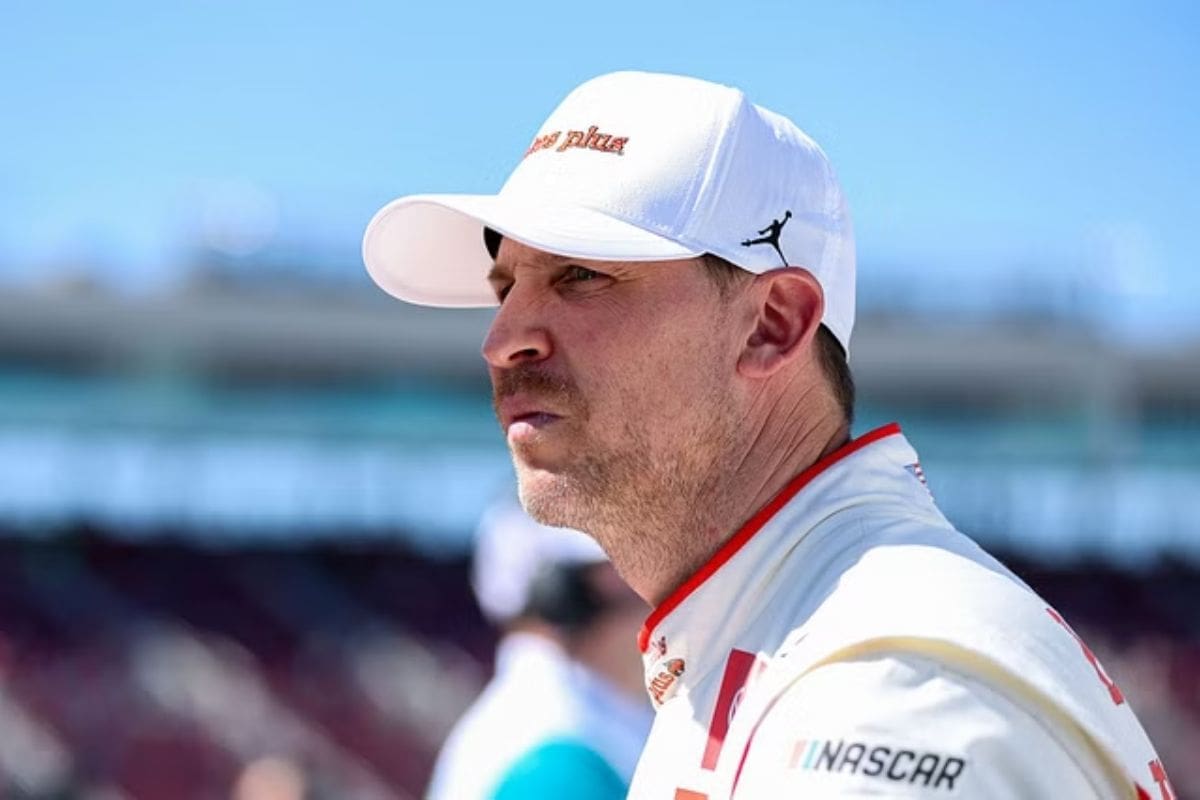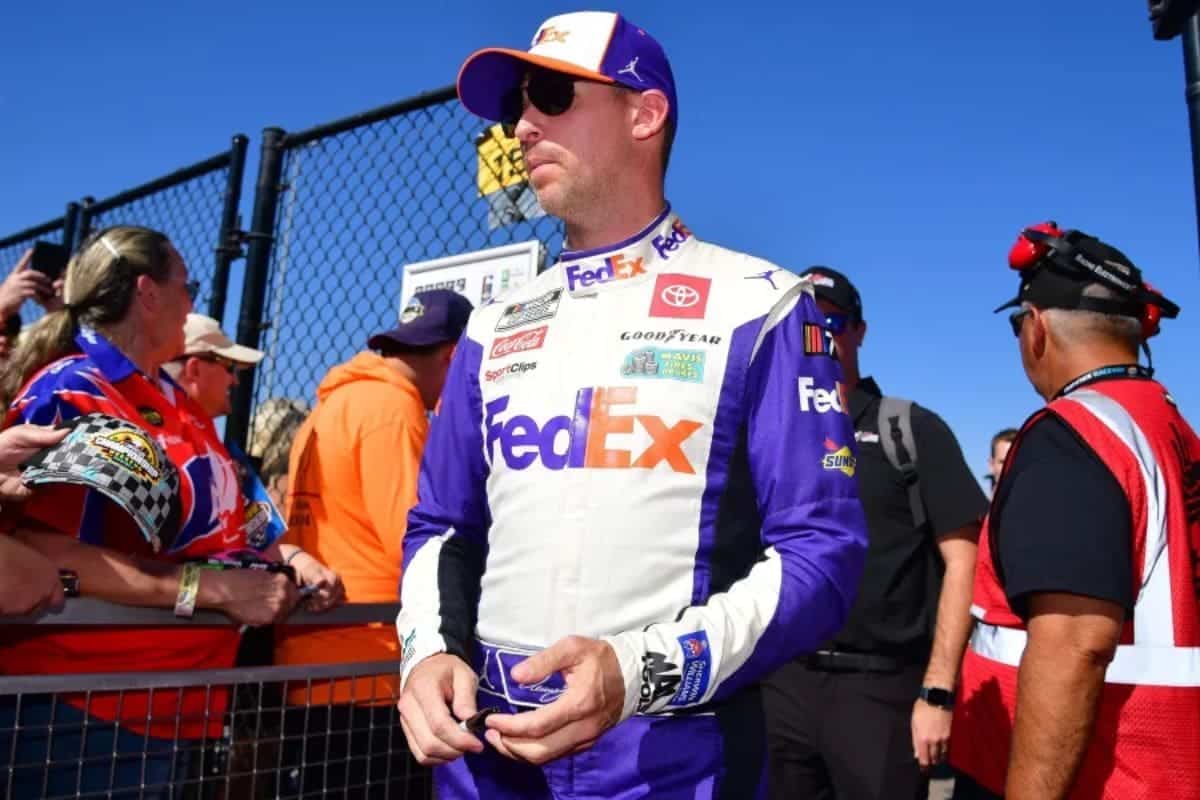Denny Hamlin Faces Goodyear’s Early Impact: Denny Hamlin‘s performance at Iowa Race Night highlighted the significant role tire technology and track conditions play in shaping race outcomes, particularly as he grappled with the intricacies of Goodyear’s tire compounds on a freshly repaved track. The altered grip levels required immediate and precise adjustments, yet Hamlin’s initial struggles with handling and understeer resulted in a noticeable drop in his position. This scenario not only emphasizes the critical nature of tire performance and car setup but also raises pertinent questions about Goodyear’s strategic approach in such dynamic racing environments.
Key Highlights
- Denny Hamlin struggled with grip and stability on Iowa Speedway’s repaved track using Goodyear tires.
- Hamlin experienced a decline in standings due to tire and handling issues.
- Unfamiliar tire compounds led to understeer and affected Hamlin’s performance.
- Goodyear’s tire performance and durability raised concerns among drivers, including Hamlin.
- Multiple tire failures disrupted Hamlin’s race strategy and competitive speed.
Denny Hamlin’s Struggles at Iowa Speedway Debut
In his much-anticipated debut at the newly repaved Iowa Speedway, Denny Hamlin, despite his storied success on short tracks, encountered a series of unforeseen challenges that hindered his performance. Entering the inaugural Iowa Corn 350, expectations were high for Hamlin, who has consistently demonstrated a formidable skill on short tracks. However, the freshly repaved 0.875-mile oval, dubbed the ‘world’s fastest short track,’ presented a new set of variables that even a seasoned driver like Hamlin found difficult to navigate.
The repave altered the track’s grip levels, creating a surface that was simultaneously smoother and faster but also unpredictable due to its novelty. Hamlin’s approach, honed through years of short-track victories, needed rapid adaptation to the unfamiliar conditions. As a driver known for his dexterity and strategic skills, Hamlin had to reassess his driving style to accommodate the altered dynamics of this revamped circuit.
Furthermore, the interaction between the new asphalt and Goodyear’s tire compounds added complexity. The tires, designed to complement the new surface, behaved differently under racing conditions, impacting Hamlin’s ability to find the best balance between speed and control. This was compounded by the high-speed nature of the track, which demanded precision and consistency—qualities Hamlin typically excels in but found elusive during this outing.
Challenges Faced by Denny Hamlin
Despite his extensive experience and notable success on short tracks, Denny Hamlin encountered significant obstacles at Iowa Speedway, highlighting the multifaceted nature of adapting to freshly repaved circuits and novel tire compounds. Hamlin, along with a subset of drivers, had never previously navigated Iowa’s pavement, a fact that became apparent as he struggled in Stage 1. Hamlin’s #11 Interstate Batteries Toyota Camry XSE fell rapidly down the running order, going a lap down by the 34th rotation on the Newton oval.
The early laps demonstrated the intricacies and challenges of adapting to a track with distinct characteristics and a surface unfamiliar to many. Hamlin’s initial missteps can be attributed to several factors, including the recent repaving of the circuit and the unique properties of the tires provided by Goodyear for this race. The interplay between these elements required a keen understanding and swift adjustment, areas where even seasoned veterans like Hamlin can struggle when faced with new variables.
Tire and Handling Issues
Denny Hamlin’s struggles with tire and handling issues were vividly highlighted by his radio communication, where he expressed frustration with the car’s performance, likening it to having the tires mounted backward. This vivid analogy highlights the severity of the handling problems he was experiencing. Such a statement reflects not only the vital grip and balance of the vehicle but also the potential misalignment of the car’s setup with the track’s demands.
“It’s like the tires are on backward.” – (hamlin)
From an analytical perspective, Hamlin’s description of ‘plowing’ suggests excessive understeer, where the front tires fail to grip adequately, causing the car to struggle in turning. This issue could be attributed to several factors, including improper tire inflation, flawed suspension settings, or even an inherent mismatch between the tire compound provided by Goodyear and the specific track conditions at Iowa.
The feedback from Hamlin’s radio communications is crucial for the crew as it provides real-time data on the car’s performance, enabling them to make necessary adjustments. However, the challenge lies in diagnosing whether the problem originates from the tires themselves or other setup variables. Given Goodyear’s role as the exclusive tire supplier, their product’s performance is vital, and any lapses can have a significant impact on a driver’s race strategy and standing.
Track Conditions and Feedback from Other Drivers
Other drivers also reported significant challenges with the track conditions at Iowa, highlighting the unpredictable tire falloff and its impact on race strategies. This phenomenon was not isolated to Denny Hamlin; different competitors experienced similar difficulties, which greatly influenced their approach to the race. Even Ryan Blaney, who managed to win a stage, commented on his struggles with tire management, stating that he was ‘trying to save his stuff’ before ultimately overtaking Kyle Larson.
Ryan Blaney (P2) says he's trying to save his stuff. This is now 25 laps into a run, where on Friday it seemed the tires were going down after 20-ish laps.
— Jeff Gluck (@jeff_gluck) June 16, 2024
- Tire Degradation: The rapid and unpredictable tire wear altered the handling characteristics of the cars, forcing drivers to adapt continuously.
- Race Strategy: Teams had to reconsider their strategies mid-race, balancing between aggressive driving and conserving tire integrity.
- Driver Feedback: Many drivers, including some from top teams, voiced concerns over their ability to maintain competitive speeds without risking excessive tire wear.
- Track Surface: The unique texture and composition of the Iowa track contributed to the accelerated tire degradation, presenting a stark contrast to other circuits.
- Performance Variability: The disparity in how different cars responded to the track conditions created an uneven playing field, complicating predictions and tactical decisions.
The drivers’ feedback highlights the critical role of tire performance in race outcomes. As seen with Hamlin’s struggle finishing P34 in the initial stage and Blaney’s cautious yet successful approach, adapting to these variables proved essential. The collective experience at Iowa suggests a need for further evaluation of tire durability and track compatibility to ensure safer and more consistent race conditions. This discussion emphasizes the intricate balance teams must strike between speed and sustainability, a confirmation of the dynamic nature of motorsport competition.
Goodyear’s Involvement and Future Outlook
Blaney was a champion at Iowa when the Xfinity and Truck Series held regular races there from 2009 to 2019. Given the widespread tire issues observed during the Iowa race, Goodyear’s role in supplying the tire compounds has come under intense scrutiny.
The recent repaving of turns 2 and 4 at Iowa Speedway was meant to improve racing conditions, yet it may have accidentally contributed to the tire failures that plagued both the Xfinity and Truck Series races. This has led to concerns regarding the adequacy of Goodyear’s tire compounds for the newly modified track surface.
However, without an official statement from Goodyear, these speculations remain just that. Meanwhile, the official Twitter account of Goodyear Racing keeps viewers informed.
“NASCAR Cup teams will have 10 sets of Goodyear Eagles for their 350-lap, 306.25-mile race at @iowaspeedway.” – (Goodyear Racing)
Looking ahead, Goodyear must address these concerns to maintain its reputation and guarantee the safety and performance standards expected in NASCAR. Potential steps include revisiting tire compound formulations and collaborating closely with track officials to better understand the implications of track modifications. The goal will be to develop a tire that can withstand the unique demands of Iowa Speedway while improving the racing experience.
Goodyear’s Fast Facts for Iowa also mention that the tire setups for the Cup race will be the same as those used at North Wilkesboro in All-Star race. This could give some hope of familiarity to the 36 drivers registered for Sunday’s race.
Did not except @dennyhamlin to run so poorly… he was my pick to win. @Blaney just put him a lap down which is the second time he has been a lap down today.
Actions Detrimental will be an interesting episode this week…#IowaCorn350/#NASCAR
👨💻: @newsfromthepits
— Zach Arnold (@zacharnold88) June 17, 2024
After restarting Stage 2 following a long pit stop to make “major changes to the car,” as Jordan Bianchi reported, Hamlin complained that his car was “still really tight.” Additionally, Hamlin went a lap down again in Stage 2 while Ryan Blaney continued to dominate Iowa, staying in the front two spots for most of the race. These issues could be costly for Denny Hamlin, who had already registered a DNF early last weekend in Sonoma.
With his battle against Kyle Larson for the top of the points table, Hamlin’s team must quickly resolve his tire issues at NASCAR Iowa.
News in Brief: Denny Hamlin Faces Goodyear’s Early Impact
The Iowa Race Night at Iowa Speedway highlighted the significant impact of Goodyear’s tire compounds on race performance. Denny Hamlin’s struggles with the repaved track’s altered grip levels demonstrated this connection. The challenges of adapting to new track conditions emphasized the critical interplay between tire performance, car setup, and driver feedback.
Hamlin’s experience showed the importance of continuous optimization in racing strategies and vehicle adjustments. It indicated that future success depends on collaborative efforts among drivers, teams, and tire manufacturers.
ALSO READ: Denny Hamlin Eyes Martin Truex Jr. for Future 23XI Racing Seat



